Metal Framework Construction
Advantages of Using Steel FramesCurrently, buildings in the country are constructed using either steel frames or concrete frames. The choice between these two methods depends on various factors such as the climate of the region, budget, conditions and quality of execution, technical aspects of the structure, and more. This decision is made by experienced engineers. Engineers and employers determine the type of framing for the building by considering various factors. Steel framing has been used in buildings from ancient times to the present day, and its advantages in different aspects have made it prevalent in most structures and buildings. Here are some of these advantages:Speed of Frame ConstructionWhile the old building is being demolished and excavation is being carried out, the steel frame can be constructed in the factory. Thus, the project completion speed will be higher, and naturally, the time costs of the project will be lower, leading to greater financial efficiency.Simplicity of On-site InstallationThe main construction operations are performed in the factory; hence, steel framing is implemented on-site much more easily compared to concrete framing. Additionally, quality control with a higher standard is possible in the factory.Higher Final EfficiencyThe duration of steel frame construction is shorter compared to concrete framing. As a result, the project is completed faster, which naturally reduces overhead costs and leads to quicker and higher final profits. Additionally, because the columns in concrete frames are approximately three times larger than those in steel frames, more usable floor area is added to the building. This improves the quality of architectural and interior spaces for the end-user.
Steel framing has been used in buildings from ancient times to the present day, and its advantages in different aspects have made it prevalent in most structures and buildings. Here are some of these advantages:Speed of Frame ConstructionWhile the old building is being demolished and excavation is being carried out, the steel frame can be constructed in the factory. Thus, the project completion speed will be higher, and naturally, the time costs of the project will be lower, leading to greater financial efficiency.Simplicity of On-site InstallationThe main construction operations are performed in the factory; hence, steel framing is implemented on-site much more easily compared to concrete framing. Additionally, quality control with a higher standard is possible in the factory.Higher Final EfficiencyThe duration of steel frame construction is shorter compared to concrete framing. As a result, the project is completed faster, which naturally reduces overhead costs and leads to quicker and higher final profits. Additionally, because the columns in concrete frames are approximately three times larger than those in steel frames, more usable floor area is added to the building. This improves the quality of architectural and interior spaces for the end-user. Types of Steel FramesSteel frames are categorized into bolted steel frames and welded steel frames.Bolted Steel FramesIn this type of steel frame, all the steel columns and beams are pre-fabricated in the factory or workshop and then sent to the construction site. There, the steel columns and beams are connected using bolts, forming the initial steel frame of the building. Bolted steel frames are the best type among other steel frames. The construction speed with bolted steel frames is much faster than other types because the only task at the construction site is to bring in the steel columns and beams and bolt them together.Other advantages of using bolts in steel structures include the absence of residual stresses like those in welded joints, the ability to disassemble and reuse the structure, no need for skilled labor, limited need for welding tools and equipment, and quiet installation and execution. However, the main issue with constructing steel structures with bolted connections is improper hole execution and failure to adhere to the required pre-tensioning force. Next, you will be introduced to bearing and friction connections.
Types of Steel FramesSteel frames are categorized into bolted steel frames and welded steel frames.Bolted Steel FramesIn this type of steel frame, all the steel columns and beams are pre-fabricated in the factory or workshop and then sent to the construction site. There, the steel columns and beams are connected using bolts, forming the initial steel frame of the building. Bolted steel frames are the best type among other steel frames. The construction speed with bolted steel frames is much faster than other types because the only task at the construction site is to bring in the steel columns and beams and bolt them together.Other advantages of using bolts in steel structures include the absence of residual stresses like those in welded joints, the ability to disassemble and reuse the structure, no need for skilled labor, limited need for welding tools and equipment, and quiet installation and execution. However, the main issue with constructing steel structures with bolted connections is improper hole execution and failure to adhere to the required pre-tensioning force. Next, you will be introduced to bearing and friction connections.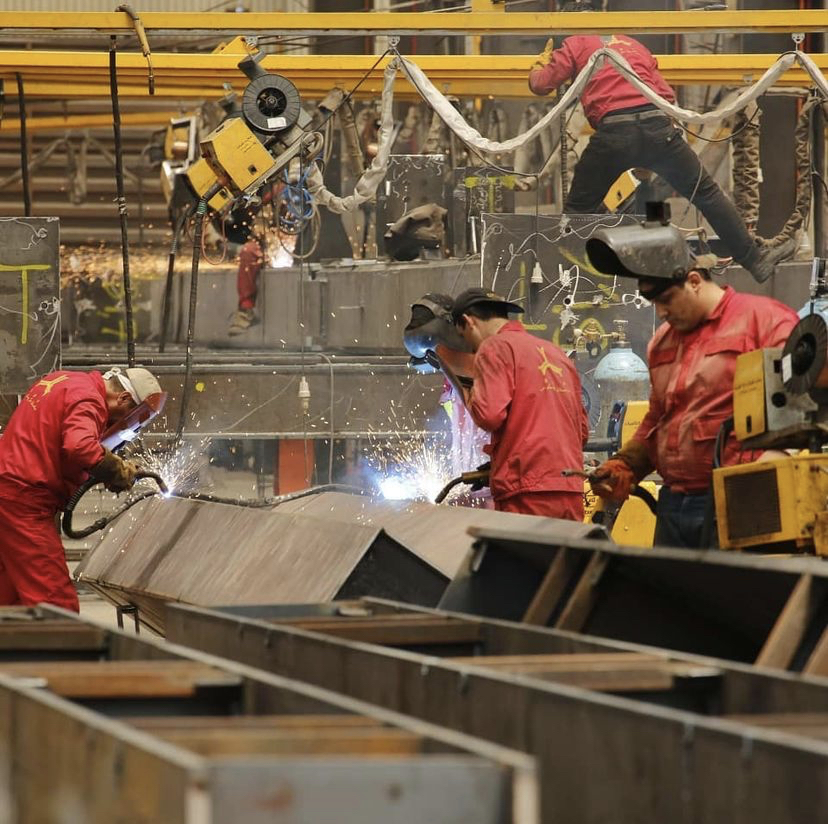 Welded Steel FrameIn the welded steel frame types, all the work stages are carried out at the construction site. The beam and column parts are cut on-site and welded together to form the final shape of the steel frame. For creating welded steel frames, it is advisable to employ skilled welders.
Welded Steel FrameIn the welded steel frame types, all the work stages are carried out at the construction site. The beam and column parts are cut on-site and welded together to form the final shape of the steel frame. For creating welded steel frames, it is advisable to employ skilled welders.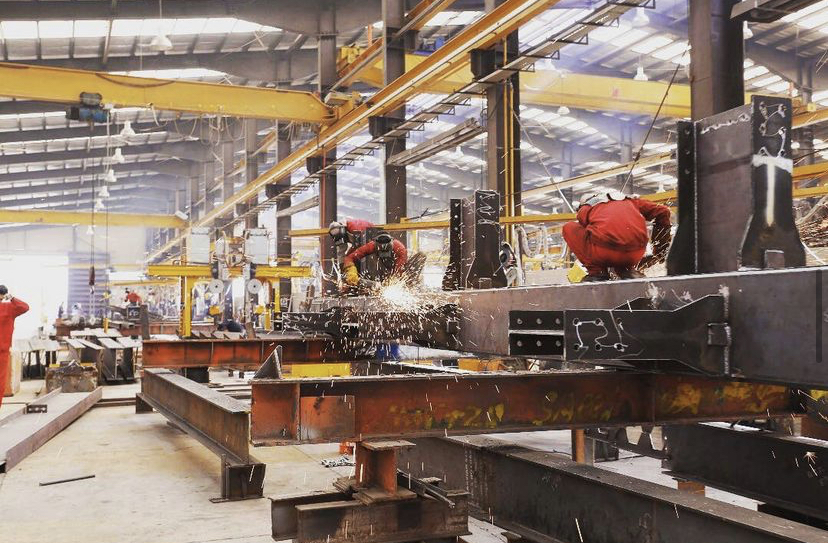 Advantages of Bolted Steel Frames over Welded FramesSome advantages of using bolted steel frames include:▪️ High Speed of Execution:The execution speed of bolted steel frames is higher than that of welded steel frames due to the elimination of welding and the simple placement of parts at the installation site. Bolted connections do not require specialized skills.▪️ Improved Construction Quality:In bolted steel frames, since the parts are fabricated in the factory under strict supervision and inspection, they exhibit higher quality compared to welded steel structures, which are constructed and installed on-site.▪️ Structural Safety and Stability:Bolted steel frames show better resistance to earthquakes compared to other types of connections in steel structures.▪️ Lower Cost:Considering the flexibility designers have in reducing the thickness and dimensions of parts and the possibility of using truss and complex connections, the cost of bolted steel structures can be expected to be lower than that of welded ones.▪️ Minimal Workspace Requirements:Due to most of the work being done in the factory, these structures can be executed in the busiest and most confined locations.▪️ Global Prevalence:In the United States and Europe, almost all structures are bolted, except in special and less important cases where welded frames are used.▪️ Utility in Disaster Management:Due to its easy assembly and erection, it can be dismantled and relocated during emergencies such as floods and fires.
Advantages of Bolted Steel Frames over Welded FramesSome advantages of using bolted steel frames include:▪️ High Speed of Execution:The execution speed of bolted steel frames is higher than that of welded steel frames due to the elimination of welding and the simple placement of parts at the installation site. Bolted connections do not require specialized skills.▪️ Improved Construction Quality:In bolted steel frames, since the parts are fabricated in the factory under strict supervision and inspection, they exhibit higher quality compared to welded steel structures, which are constructed and installed on-site.▪️ Structural Safety and Stability:Bolted steel frames show better resistance to earthquakes compared to other types of connections in steel structures.▪️ Lower Cost:Considering the flexibility designers have in reducing the thickness and dimensions of parts and the possibility of using truss and complex connections, the cost of bolted steel structures can be expected to be lower than that of welded ones.▪️ Minimal Workspace Requirements:Due to most of the work being done in the factory, these structures can be executed in the busiest and most confined locations.▪️ Global Prevalence:In the United States and Europe, almost all structures are bolted, except in special and less important cases where welded frames are used.▪️ Utility in Disaster Management:Due to its easy assembly and erection, it can be dismantled and relocated during emergencies such as floods and fires.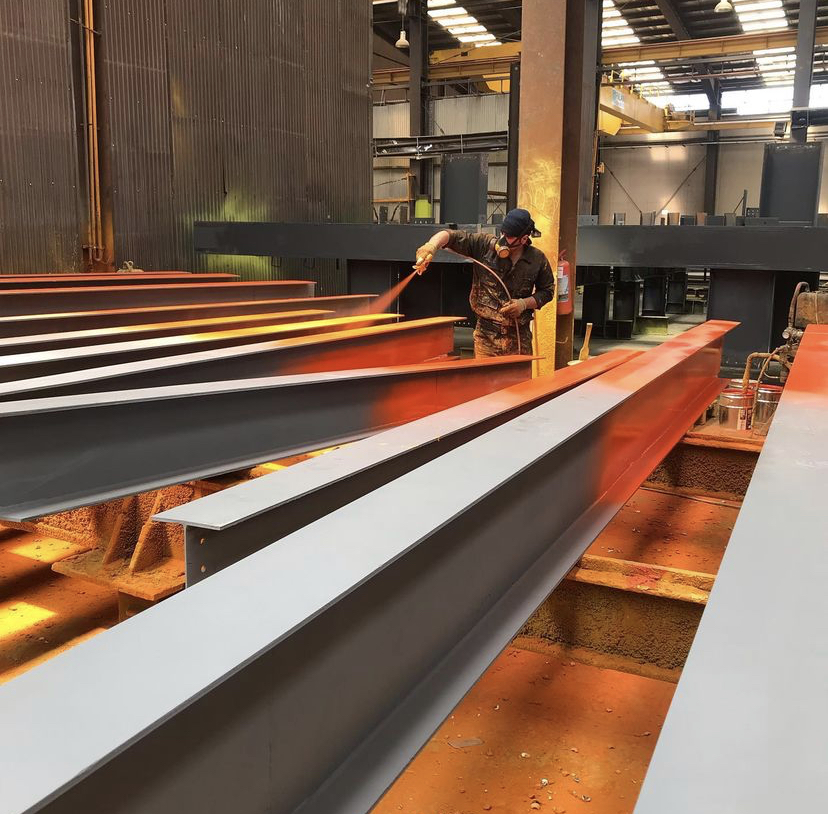 Types of Welds and Welding MethodsWelding is an integral part of the construction of steel frames, both during the manufacturing stages in the factory and at the construction site. Many components, especially in welded structures, are welded together in the factory, where a dedicated welding unit with adequate equipment is typically available. Due to the higher precision of factory welding and the differences in welding types, methods, and equipment compared to on-site welding, it is essential to be familiar with the different types of welds, commonly used methods, and their applications.Welding steel frames involves joining and integrating materials using heat, with or without the application of pressure or additional filler materials. The materials to be joined are called the base metal, and the material that creates the bond is called the filler metal or weld metal. Heat is applied to melt the base metal and the filler metal so that they become fluid and can intermingle. The most common welding methods, especially for structural steel welding, use electrical energy as the heat source, typically employing electric arc welding. An electric arc is a discharge of a relatively large current between the weld metal (electrode or welding wire) and the base metal through a column of ionized gas called plasma.In electric arc welding, the melting and bonding process occurs through the flow of materials along the arc without the application of pressure. Below is a brief introduction to the different types of welds.Types of Welds
Types of Welds and Welding MethodsWelding is an integral part of the construction of steel frames, both during the manufacturing stages in the factory and at the construction site. Many components, especially in welded structures, are welded together in the factory, where a dedicated welding unit with adequate equipment is typically available. Due to the higher precision of factory welding and the differences in welding types, methods, and equipment compared to on-site welding, it is essential to be familiar with the different types of welds, commonly used methods, and their applications.Welding steel frames involves joining and integrating materials using heat, with or without the application of pressure or additional filler materials. The materials to be joined are called the base metal, and the material that creates the bond is called the filler metal or weld metal. Heat is applied to melt the base metal and the filler metal so that they become fluid and can intermingle. The most common welding methods, especially for structural steel welding, use electrical energy as the heat source, typically employing electric arc welding. An electric arc is a discharge of a relatively large current between the weld metal (electrode or welding wire) and the base metal through a column of ionized gas called plasma.In electric arc welding, the melting and bonding process occurs through the flow of materials along the arc without the application of pressure. Below is a brief introduction to the different types of welds.Types of Welds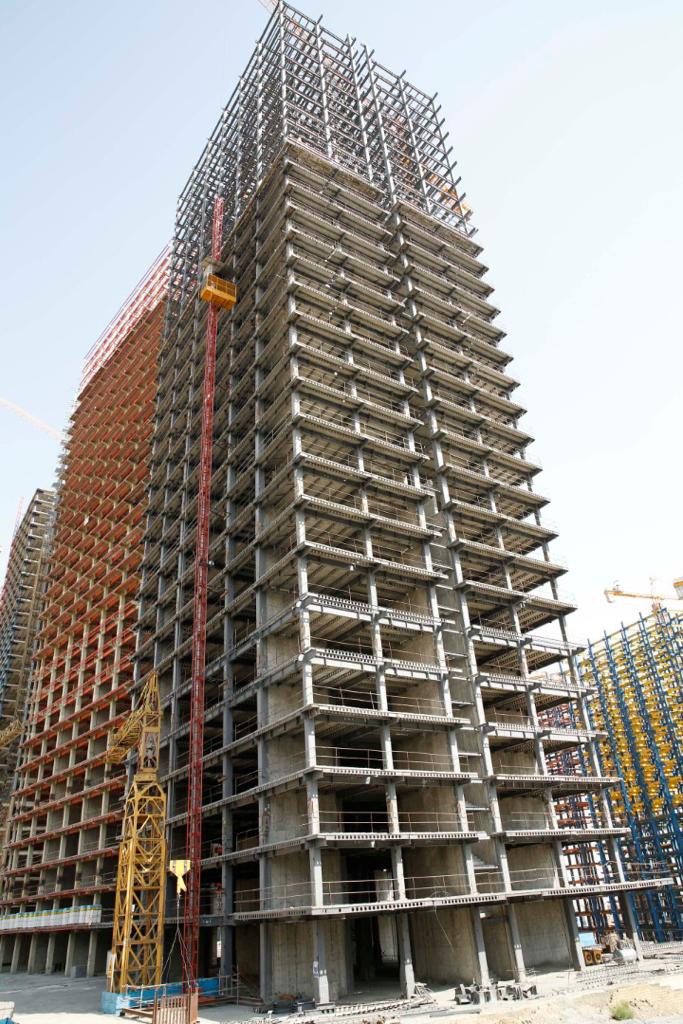 Types of Welding Inspection MethodsThe necessity of weld inspection arises because, during manufacturing, various defects of different sizes may occur in the material or part, affecting its immediate functionality. Other defects, such as fatigue cracks or corrosion, may develop during the material’s service life. Therefore, reliable tools are needed to detect defects during the manufacturing stage and to monitor their growth throughout the part’s service life. This necessity is especially important in factories producing steel frames because we expect the frames manufactured in the factory to be of higher quality and lower error rates than those constructed on-site.Weld inspection is a crucial step in the process of manufacturing steel frames in the factory. Inspectors examine and test the welds at the necessary stages.
Types of Welding Inspection MethodsThe necessity of weld inspection arises because, during manufacturing, various defects of different sizes may occur in the material or part, affecting its immediate functionality. Other defects, such as fatigue cracks or corrosion, may develop during the material’s service life. Therefore, reliable tools are needed to detect defects during the manufacturing stage and to monitor their growth throughout the part’s service life. This necessity is especially important in factories producing steel frames because we expect the frames manufactured in the factory to be of higher quality and lower error rates than those constructed on-site.Weld inspection is a crucial step in the process of manufacturing steel frames in the factory. Inspectors examine and test the welds at the necessary stages.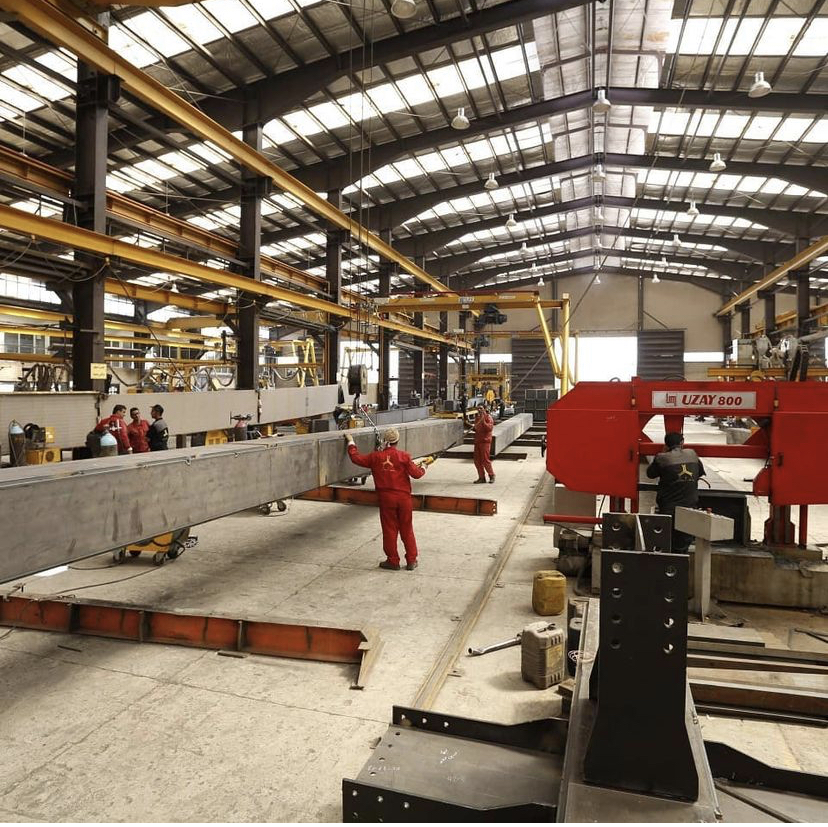 Work-Breakdown Structure (WBS) of Steel Frame ConstructionThe WBS for constructing metal structures or artifacts generally includes the following activities:
Work-Breakdown Structure (WBS) of Steel Frame ConstructionThe WBS for constructing metal structures or artifacts generally includes the following activities:
 Steel framing has been used in buildings from ancient times to the present day, and its advantages in different aspects have made it prevalent in most structures and buildings. Here are some of these advantages:Speed of Frame ConstructionWhile the old building is being demolished and excavation is being carried out, the steel frame can be constructed in the factory. Thus, the project completion speed will be higher, and naturally, the time costs of the project will be lower, leading to greater financial efficiency.Simplicity of On-site InstallationThe main construction operations are performed in the factory; hence, steel framing is implemented on-site much more easily compared to concrete framing. Additionally, quality control with a higher standard is possible in the factory.Higher Final EfficiencyThe duration of steel frame construction is shorter compared to concrete framing. As a result, the project is completed faster, which naturally reduces overhead costs and leads to quicker and higher final profits. Additionally, because the columns in concrete frames are approximately three times larger than those in steel frames, more usable floor area is added to the building. This improves the quality of architectural and interior spaces for the end-user.
Steel framing has been used in buildings from ancient times to the present day, and its advantages in different aspects have made it prevalent in most structures and buildings. Here are some of these advantages:Speed of Frame ConstructionWhile the old building is being demolished and excavation is being carried out, the steel frame can be constructed in the factory. Thus, the project completion speed will be higher, and naturally, the time costs of the project will be lower, leading to greater financial efficiency.Simplicity of On-site InstallationThe main construction operations are performed in the factory; hence, steel framing is implemented on-site much more easily compared to concrete framing. Additionally, quality control with a higher standard is possible in the factory.Higher Final EfficiencyThe duration of steel frame construction is shorter compared to concrete framing. As a result, the project is completed faster, which naturally reduces overhead costs and leads to quicker and higher final profits. Additionally, because the columns in concrete frames are approximately three times larger than those in steel frames, more usable floor area is added to the building. This improves the quality of architectural and interior spaces for the end-user. Types of Steel FramesSteel frames are categorized into bolted steel frames and welded steel frames.Bolted Steel FramesIn this type of steel frame, all the steel columns and beams are pre-fabricated in the factory or workshop and then sent to the construction site. There, the steel columns and beams are connected using bolts, forming the initial steel frame of the building. Bolted steel frames are the best type among other steel frames. The construction speed with bolted steel frames is much faster than other types because the only task at the construction site is to bring in the steel columns and beams and bolt them together.Other advantages of using bolts in steel structures include the absence of residual stresses like those in welded joints, the ability to disassemble and reuse the structure, no need for skilled labor, limited need for welding tools and equipment, and quiet installation and execution. However, the main issue with constructing steel structures with bolted connections is improper hole execution and failure to adhere to the required pre-tensioning force. Next, you will be introduced to bearing and friction connections.
Types of Steel FramesSteel frames are categorized into bolted steel frames and welded steel frames.Bolted Steel FramesIn this type of steel frame, all the steel columns and beams are pre-fabricated in the factory or workshop and then sent to the construction site. There, the steel columns and beams are connected using bolts, forming the initial steel frame of the building. Bolted steel frames are the best type among other steel frames. The construction speed with bolted steel frames is much faster than other types because the only task at the construction site is to bring in the steel columns and beams and bolt them together.Other advantages of using bolts in steel structures include the absence of residual stresses like those in welded joints, the ability to disassemble and reuse the structure, no need for skilled labor, limited need for welding tools and equipment, and quiet installation and execution. However, the main issue with constructing steel structures with bolted connections is improper hole execution and failure to adhere to the required pre-tensioning force. Next, you will be introduced to bearing and friction connections. Welded Steel FrameIn the welded steel frame types, all the work stages are carried out at the construction site. The beam and column parts are cut on-site and welded together to form the final shape of the steel frame. For creating welded steel frames, it is advisable to employ skilled welders.
Welded Steel FrameIn the welded steel frame types, all the work stages are carried out at the construction site. The beam and column parts are cut on-site and welded together to form the final shape of the steel frame. For creating welded steel frames, it is advisable to employ skilled welders. Advantages of Bolted Steel Frames over Welded FramesSome advantages of using bolted steel frames include:▪️ High Speed of Execution:The execution speed of bolted steel frames is higher than that of welded steel frames due to the elimination of welding and the simple placement of parts at the installation site. Bolted connections do not require specialized skills.▪️ Improved Construction Quality:In bolted steel frames, since the parts are fabricated in the factory under strict supervision and inspection, they exhibit higher quality compared to welded steel structures, which are constructed and installed on-site.▪️ Structural Safety and Stability:Bolted steel frames show better resistance to earthquakes compared to other types of connections in steel structures.▪️ Lower Cost:Considering the flexibility designers have in reducing the thickness and dimensions of parts and the possibility of using truss and complex connections, the cost of bolted steel structures can be expected to be lower than that of welded ones.▪️ Minimal Workspace Requirements:Due to most of the work being done in the factory, these structures can be executed in the busiest and most confined locations.▪️ Global Prevalence:In the United States and Europe, almost all structures are bolted, except in special and less important cases where welded frames are used.▪️ Utility in Disaster Management:Due to its easy assembly and erection, it can be dismantled and relocated during emergencies such as floods and fires.
Advantages of Bolted Steel Frames over Welded FramesSome advantages of using bolted steel frames include:▪️ High Speed of Execution:The execution speed of bolted steel frames is higher than that of welded steel frames due to the elimination of welding and the simple placement of parts at the installation site. Bolted connections do not require specialized skills.▪️ Improved Construction Quality:In bolted steel frames, since the parts are fabricated in the factory under strict supervision and inspection, they exhibit higher quality compared to welded steel structures, which are constructed and installed on-site.▪️ Structural Safety and Stability:Bolted steel frames show better resistance to earthquakes compared to other types of connections in steel structures.▪️ Lower Cost:Considering the flexibility designers have in reducing the thickness and dimensions of parts and the possibility of using truss and complex connections, the cost of bolted steel structures can be expected to be lower than that of welded ones.▪️ Minimal Workspace Requirements:Due to most of the work being done in the factory, these structures can be executed in the busiest and most confined locations.▪️ Global Prevalence:In the United States and Europe, almost all structures are bolted, except in special and less important cases where welded frames are used.▪️ Utility in Disaster Management:Due to its easy assembly and erection, it can be dismantled and relocated during emergencies such as floods and fires. Types of Welds and Welding MethodsWelding is an integral part of the construction of steel frames, both during the manufacturing stages in the factory and at the construction site. Many components, especially in welded structures, are welded together in the factory, where a dedicated welding unit with adequate equipment is typically available. Due to the higher precision of factory welding and the differences in welding types, methods, and equipment compared to on-site welding, it is essential to be familiar with the different types of welds, commonly used methods, and their applications.Welding steel frames involves joining and integrating materials using heat, with or without the application of pressure or additional filler materials. The materials to be joined are called the base metal, and the material that creates the bond is called the filler metal or weld metal. Heat is applied to melt the base metal and the filler metal so that they become fluid and can intermingle. The most common welding methods, especially for structural steel welding, use electrical energy as the heat source, typically employing electric arc welding. An electric arc is a discharge of a relatively large current between the weld metal (electrode or welding wire) and the base metal through a column of ionized gas called plasma.In electric arc welding, the melting and bonding process occurs through the flow of materials along the arc without the application of pressure. Below is a brief introduction to the different types of welds.Types of Welds
Types of Welds and Welding MethodsWelding is an integral part of the construction of steel frames, both during the manufacturing stages in the factory and at the construction site. Many components, especially in welded structures, are welded together in the factory, where a dedicated welding unit with adequate equipment is typically available. Due to the higher precision of factory welding and the differences in welding types, methods, and equipment compared to on-site welding, it is essential to be familiar with the different types of welds, commonly used methods, and their applications.Welding steel frames involves joining and integrating materials using heat, with or without the application of pressure or additional filler materials. The materials to be joined are called the base metal, and the material that creates the bond is called the filler metal or weld metal. Heat is applied to melt the base metal and the filler metal so that they become fluid and can intermingle. The most common welding methods, especially for structural steel welding, use electrical energy as the heat source, typically employing electric arc welding. An electric arc is a discharge of a relatively large current between the weld metal (electrode or welding wire) and the base metal through a column of ionized gas called plasma.In electric arc welding, the melting and bonding process occurs through the flow of materials along the arc without the application of pressure. Below is a brief introduction to the different types of welds.Types of Welds- Fillet weld
- Groove weld
- Slot weld
- Plug weld
 Types of Welding Inspection MethodsThe necessity of weld inspection arises because, during manufacturing, various defects of different sizes may occur in the material or part, affecting its immediate functionality. Other defects, such as fatigue cracks or corrosion, may develop during the material’s service life. Therefore, reliable tools are needed to detect defects during the manufacturing stage and to monitor their growth throughout the part’s service life. This necessity is especially important in factories producing steel frames because we expect the frames manufactured in the factory to be of higher quality and lower error rates than those constructed on-site.Weld inspection is a crucial step in the process of manufacturing steel frames in the factory. Inspectors examine and test the welds at the necessary stages.
Types of Welding Inspection MethodsThe necessity of weld inspection arises because, during manufacturing, various defects of different sizes may occur in the material or part, affecting its immediate functionality. Other defects, such as fatigue cracks or corrosion, may develop during the material’s service life. Therefore, reliable tools are needed to detect defects during the manufacturing stage and to monitor their growth throughout the part’s service life. This necessity is especially important in factories producing steel frames because we expect the frames manufactured in the factory to be of higher quality and lower error rates than those constructed on-site.Weld inspection is a crucial step in the process of manufacturing steel frames in the factory. Inspectors examine and test the welds at the necessary stages. Work-Breakdown Structure (WBS) of Steel Frame ConstructionThe WBS for constructing metal structures or artifacts generally includes the following activities:
Work-Breakdown Structure (WBS) of Steel Frame ConstructionThe WBS for constructing metal structures or artifacts generally includes the following activities:- Engineering activities
- Material procurement
- Initial cleaning and sandblasting
- Cutting
- Initial assembly
- Welding
- Final assembly
- Final welding
- Cleaning and sandblasting
- Painting
- Packing, loading, and transportation
- Installation
Do you need specialized consultation?
Our engineers are ready to serve and advise you for the best experience in any style you prefer. Please fill out the form below, and we will contact you at the earliest opportunity.